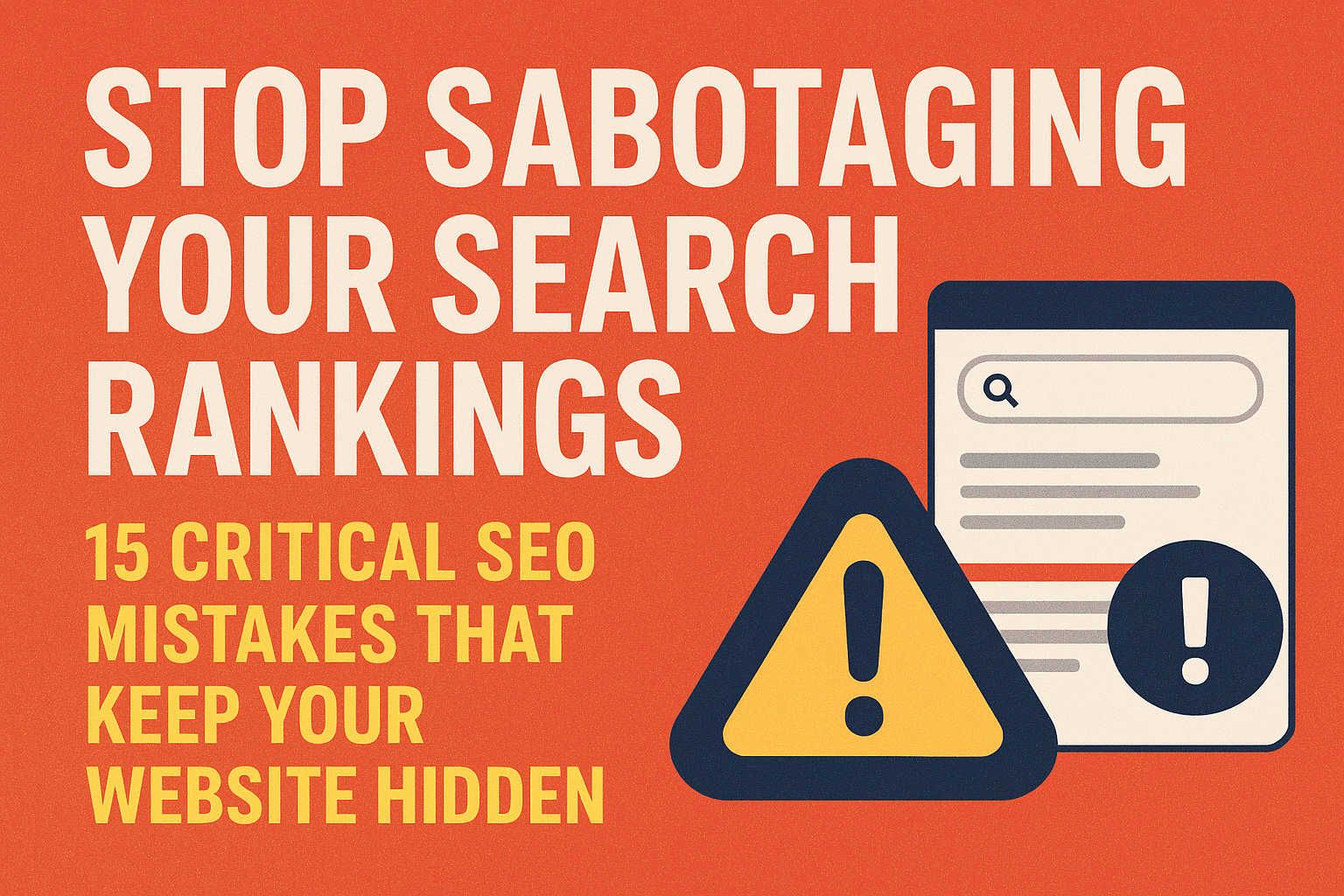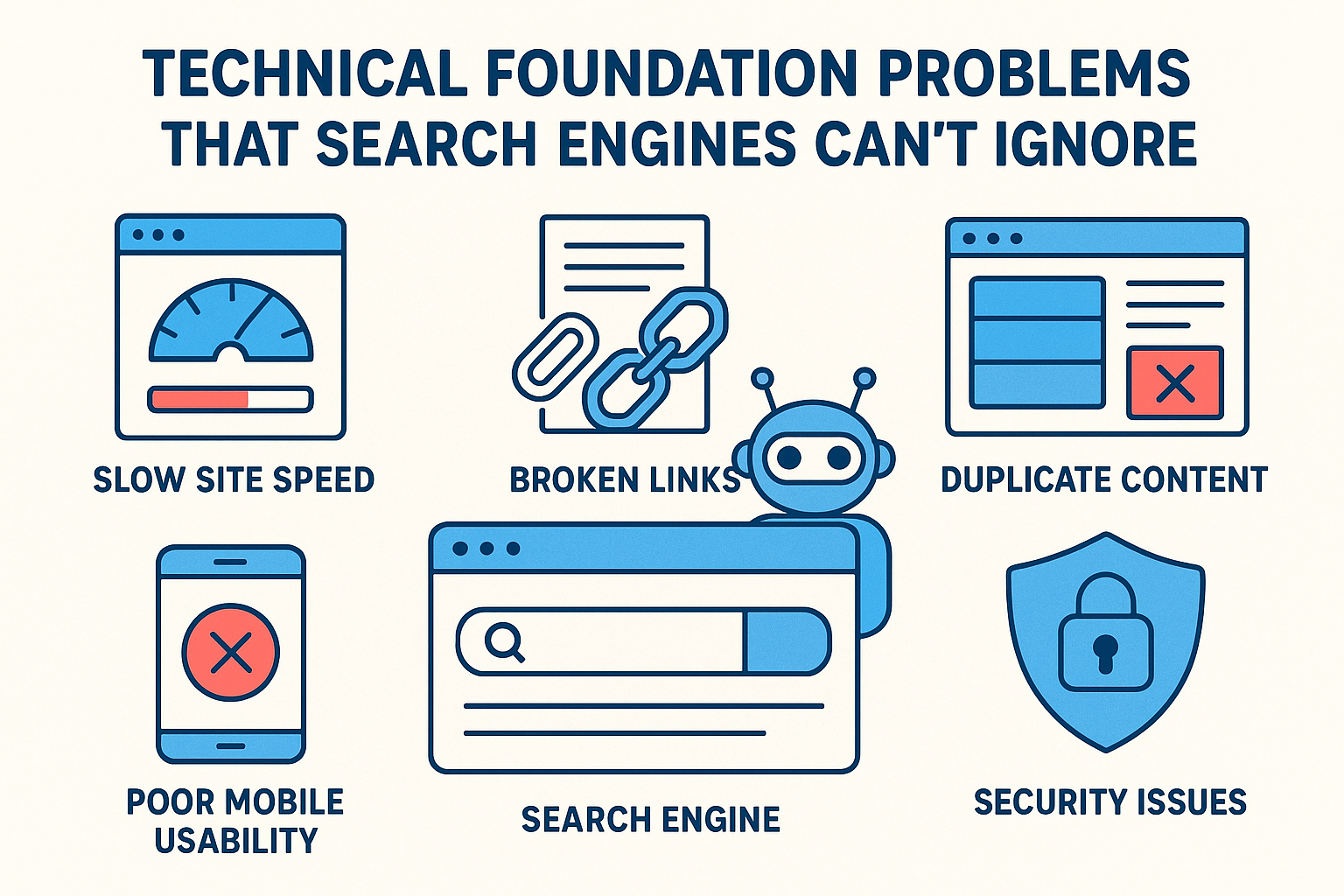Stop Sabotaging Your Search Rankings: 15 Critical SEO Mistakes That Keep Your Website Hidden
🗓️Published: Sep 2025, 🕑 15 min. read
“If your website is hidden from search, it’s not Google’s fault—it’s yours.” — Neil Patel

Introduction
In today’s hyper-competitive digital world, SEO isn’t just a nice-to-have—it’s the lifeline of online visibility. Yet many websites unknowingly sabotage their rankings through avoidable mistakes. These errors—some technical, others strategic—can quietly erode your traffic, credibility, and conversions. This guide breaks down 15 of the most damaging SEO missteps and offers practical, research-backed solutions to help your site shine on Google.
Table of Contents
- Technical Foundation Problems That Search Engines Can’t Ignore
1.1 Poor Website Loading Speed Performance
1.2 Mobile-Unfriendly Website Design and Functionality
1.3 Broken Internal Links and Navigation Errors
- Content Strategy Missteps That Confuse Search Engines
2.1 Keyword Stuffing and Over-Optimization Penalties
2.2 Duplicate Content Issues Across Multiple Pages
2.3 Thin Content That Fails to Satisfy Search Intent
- On-Page Optimization Errors That Reduce Visibility
3.1 Missing or Poorly Written Title Tags and Meta Descriptions
3.2 Improper Header Tag Structure and Hierarchy
3.3 Image Optimization Failures and Accessibility Issues
- Technical SEO Oversights That Block Search Engine Access
4.1 Incorrect Robots.txt File Configuration
4.2 XML Sitemap Problems and Submission Errors
4.3 SSL Certificate Issues and Website Security Problems
- Link Building and Authority Mistakes That Damage Trust
5.1 Poor Quality Backlink Acquisition Strategies
5.2 Neglecting Internal Link Strategy and Page Authority Distribution
5.3 Ignoring Local SEO Signals and Geographic Optimization
Frequently Asked Questions (FAQs)
Turn SEO Mistakes into Strategic Wins
Actionable Next Steps
Final Thought

1. Technical Foundation Problems That Search Engines Can’t Ignore
1.1 Poor Website Loading Speed Performance
A slow-loading site is like a slow waiter—frustrating and forgettable. Google’s Core Web Vitals prioritize speed because users do. Pages that take longer than 3 seconds to load see bounce rates soar. Common culprits include oversized images, bloated JavaScript, and sluggish hosting. Use tools like Google PageSpeed Insights or GTmetrix to diagnose issues. Compress images, enable lazy loading, and consider a CDN to boost performance.
1.2 Mobile-Unfriendly Website Design and Functionality
With mobile traffic dominating search, Google’s mobile-first indexing means your mobile site is now your primary site. If your design isn’t responsive or your buttons are too tiny to tap, you’re losing both users and rankings. Run your site through Google’s Mobile-Friendly Test and fix layout issues, font sizes, and navigation glitches. AMP (Accelerated Mobile Pages) can also help speed things up for mobile users.
1.3 Broken Internal Links and Website Navigation Errors
Broken links don’t just frustrate users—they confuse search engines. Redirect chains, 404 errors, and orphaned pages can disrupt crawling and dilute link equity. Regularly audit your site using tools like Screaming Frog or Ahrefs Site Audit. Fix broken links, streamline redirects, and ensure your navigation is intuitive and crawlable.
2. Content Strategy Missteps That Confuse Search Engines
2.1 Keyword Stuffing and Over-Optimization Penalties
Gone are the days of cramming keywords into every sentence. Google now uses natural language processing to understand context. If your content feels robotic or repetitive, it’s likely hurting your rankings. Instead, focus on semantic relevance and readability. Use keywords naturally, and prioritize helpfulness over density.
2.2 Duplicate Content Issues Across Multiple Pages
Duplicate content—whether intentional or accidental—can confuse Google and split your ranking potential. This often happens with product pages, blog tags, or poorly implemented canonical tags. Use tools like Copyscape or Siteliner to identify duplicates. Consolidate similar pages, use canonical URLs correctly, and ensure each page offers unique value.
2.3 Thin Content That Fails to Satisfy Search Intent
A 300-word blog post might check the “content” box, but if it doesn’t answer the user’s question, it’s thin. Google rewards depth, clarity, and relevance. Understand the intent behind each keyword—informational, transactional, navigational—and build content that fully satisfies it. Add FAQs, visuals, and examples to enrich your pages.
3. On-Page Optimization Errors That Reduce Visibility
3.1 Missing or Poorly Written Title Tags and Meta Descriptions
Your title tag is your first impression on Google. A vague or missing title can tank your click-through rate. Meta descriptions, while not a ranking factor, influence user behavior. Keep titles under 60 characters and meta descriptions under 160. Include your primary keyword and a compelling reason to click.
3.2 Improper Header Tag Structure and Hierarchy
Header tags (H1–H6) aren’t just for styling—they guide both users and search engines through your content. Misusing them (e.g., multiple H1s or skipping levels) can confuse crawlers. Use one H1 per page, followed by logical H2s and H3s. Think of it like outlining a book: clear structure equals better comprehension.
3.3 Image Optimization Failures and Accessibility Issues
Images without alt text are invisible to search engines and inaccessible to visually impaired users. Large image files also slow down your site. Use descriptive alt text, compress images, and choose the right format (WebP is great for web). Bonus: optimized images can rank in Google Image Search, driving extra traffic.
4. Technical SEO Oversights That Block Search Engine Access
4.1 Incorrect Robots.txt File Configuration
Your robots.txt file tells search engines what to crawl—and what to skip. A single misplaced “Disallow” directive can block your entire site. Check your robots.txt at yourdomain.com/robots.txt and ensure critical pages aren’t accidentally excluded. Use Google Search Console’s robots.txt tester to validate your setup.
4.2 XML Sitemap Problems and Submission Errors
Sitemaps help Google discover your pages. Missing or outdated sitemaps can leave important content unindexed. Use tools like Yoast SEO or Screaming Frog to generate clean XML sitemaps. Submit them via Google Search Console and update them as your site evolves.
4.3 SSL Certificate Issues and Website Security Problems
Google favors secure sites. If your SSL certificate is missing or expired, users will see scary warnings—and bounce. Mixed content (HTTP elements on HTTPS pages) can also trigger security alerts. Use HTTPS across your site, fix mixed content issues, and renew certificates before they expire.
5. Link Building and Authority Mistakes That Damage Trust
5.1 Poor Quality Backlink Acquisition Strategies
Buying backlinks or joining shady link schemes might offer short-term gains, but Google’s algorithms are ruthless. Low-quality links can trigger penalties and tank your rankings. Focus on earning links through guest posts, digital PR, and content worth sharing. Quality beats quantity every time.
5.2 Neglecting Internal Link Strategy and Page Authority Distribution
Internal links help search engines understand your site’s structure and distribute authority. Without them, important pages may remain hidden. Link from high-traffic pages to strategic ones, use descriptive anchor text, and avoid orphan pages. Think of internal linking as building roads between your content.
5.3 Ignoring Local SEO Signals and Geographic Optimization
If you’re targeting local customers, ignoring local SEO is a missed opportunity. Incomplete Google Business Profiles, inconsistent NAP info, and lack of local citations can hurt visibility. Claim and optimize your profile, encourage reviews, and build local backlinks to boost geographic relevance.
These 15 SEO mistakes aren’t just technical glitches—they’re silent killers of visibility, traffic, and trust. From slow-loading pages to thin content and broken links, each issue chips away at your search performance. Regular audits, strategic fixes, and ongoing optimization are your best defense. Treat SEO like a living system—nurture it, and it will grow.
Frequently Asked Questions (FAQs)
Q: How long does it take to see improvements after fixing these SEO mistakes?
A: Technical fixes can show results within days, while content and authority improvements may take 2–6 months depending on competition and crawl frequency.
Q: Should I fix all 15 mistakes at once or prioritize certain areas first?
A: Start with technical and content-related issues—they have the biggest impact. Then move on to on-page and link-building strategies.
Q: How can I identify which of these mistakes are affecting my website?
A: Use tools like Google Search Console, PageSpeed Insights, Screaming Frog, and Ahrefs Site Audit to uncover issues. A full SEO audit is ideal.
Q: Are these SEO mistakes more harmful for new websites or established ones?
A: New sites are more vulnerable, but older sites often have legacy issues that require deeper audits. Both need regular checkups.
Q: Can fixing these SEO mistakes guarantee better search rankings?
A: Fixing mistakes removes barriers, but ranking also depends on competition, content quality, and ongoing effort. SEO is a marathon, not a sprint.
Turn SEO Mistakes into Strategic Wins
Fixing SEO mistakes isn’t just about damage control—it’s about unlocking your website’s full potential. Each correction you make improves not only your visibility but also your user experience, credibility, and conversion rates. Think of this process as digital spring cleaning: clearing out clutter, tightening your structure, and making your site shine for both users and search engines.
Here’s how to move forward strategically:
Actionable Next Steps
- Run a full-site audit using tools like Google Search Console, Screaming Frog, or Ahrefs Site Audit.
- Prioritize fixes based on impact: start with technical errors, then tackle content and link-building issues.
- Schedule monthly SEO check-ins to catch new problems early and stay aligned with Google’s evolving algorithms.
- Invest in education: Follow trusted SEO blogs like Moz, Search Engine Journal, and Backlinko for ongoing insights.
Final Thought
SEO isn’t a one-time fix—it’s a continuous conversation between your website and search engines. By turning these 15 common mistakes into learning opportunities, you’re not just improving rankings—you’re building a resilient, high-performing digital presence. Stay curious, stay consistent, and let your content speak louder than your competitors.
